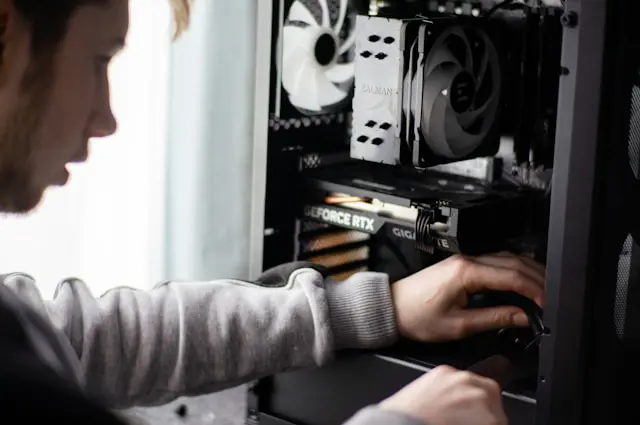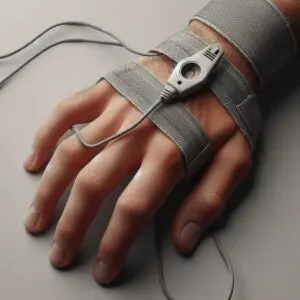
Before diving into any upgrade, fix, or troubleshooting task, it’s important to start with one key rule: always put safety first. Working with computer hardware can expose you to electrical risks, delicate components, and other hazards. Taking a few simple precautions can go a long way — by following proper safety protocols, you can avoid accidents, protect your hardware, and give yourself the best shot at a successful repair.
In this post, we’ll explore essential computer repair safety tips under four key areas. The good news? You don’t need to be an expert to stay safe. Whether you’re a beginner or an experienced DIYer, you can follow these guidelines to stay safe and confident while handling your PC.
Preparing for Safe Repairs
Now that you know safety comes first, let’s talk about where to start.
Set up a safe and organized workspace before diving into your repair task.
- Power Down and Disconnect
- Always turn off your computer and unplug it from the power outlet. This prevents electric shock and damage to components.
- If working on a laptop, remove the battery if possible.
- Gather the Right Tools
- Once your workspace is ready, make sure you’ve got the right tools on hand.
Use tools specifically designed for computer repair, such as an anti-static wrist strap, screwdrivers, and spudgers. Avoid makeshift tools that could damage components.
- Once your workspace is ready, make sure you’ve got the right tools on hand.
- Organize Your Workspace
- Choose a flat, clean, and well-lit area to work in. Avoid carpets, as they generate static electricity.
- Keep screws and small parts organized by storing them in containers to avoid losing them.
- Backup Your Data
- Tools? Check. Now, before you start taking things apart, there’s one more smart step to take:
Back up important data in case something goes wrong.
- Tools? Check. Now, before you start taking things apart, there’s one more smart step to take:
Handling Components Safely
Mishandling or static electricity can easily damage delicate computer components.
- Use Anti-Static Measures
- Wear an anti-static wrist strap and ground yourself to prevent static discharge,
 which can fry sensitive components.
which can fry sensitive components. - Work on a non-conductive surface and avoid touching components with bare hands.
- Wear an anti-static wrist strap and ground yourself to prevent static discharge,
- Hold Components Correctly
- Handle parts like RAM and GPUs by their edges, avoiding contact with circuit boards or pins.
- Once you’re ready to work on the hardware itself, remember to take your time.
Never force a component into place—double-check compatibility and alignment before applying pressure.
- Keep Components Clean
- While you’re working inside your PC, it’s also a good opportunity to clean things up a bit.
Use compressed air to clean parts, and avoid using liquids unless specifically designed for electronics.
- While you’re working inside your PC, it’s also a good opportunity to clean things up a bit.
Electrical and Environmental Safety
Along with careful handling and cleaning, it’s important to stay aware of electrical risks.
Electrical hazards are a real risk when repairing computers, so take extra precautions.
- Unplug Power Supplies
- One of the simplest ways to stay safe is also the most important:
Always unplug and power down your PC before working on it, even when you’re just replacing peripherals.
- One of the simplest ways to stay safe is also the most important:
- Avoid Moisture and Liquids
- Keep your workspace dry and free from beverages. Liquid spills can cause short circuits and permanent damage.
- Ventilation and Temperature
- While you’re at it, don’t forget about your workspace environment.
Ensure good ventilation while working to avoid overheating. Be mindful of static buildup in dry or high-temperature environments.
- While you’re at it, don’t forget about your workspace environment.
- Proper Lighting
- Another thing that makes a big difference? Lighting.
Good lighting reduces the risk of mistakes or dropping parts, especially when dealing with small screws or connectors.
- Another thing that makes a big difference? Lighting.
Final Checks and Preventive Measures
After you’ve finished your repair, don’t rush to hit the power button just yet.
Once your repair is complete, double-check everything before powering on your computer.
- Inspect Connections and Placement
- Securely install and properly connect all components. Loose wires or misaligned components can cause malfunctions.
- Test Before Full Assembly
- It’s much easier to catch any issues if you power up your PC and check that everything’s working before you screw everything back together.
- Monitor for Issues
- After completing repairs, keep an eye on your system’s performance to catch potential problems early.
- Learn Preventive Maintenance
- Regularly clean your PC, update software, and check for signs of wear to reduce the need for future repairs.
Conclusion
If everything looks good during testing, you’re almost there!
Repairing your computer can be a rewarding and cost-effective experience, but safety should always be a priority. By preparing your workspace, handling components correctly, and following essential electrical safety measures, you can confidently tackle repairs while protecting yourself and your hardware.
Do you have any go-to safety tips or repair experiences to share? Drop them in the comments below—we’d love to hear from you and learn more about your approach to PC care!

 which can fry sensitive components.
which can fry sensitive components.